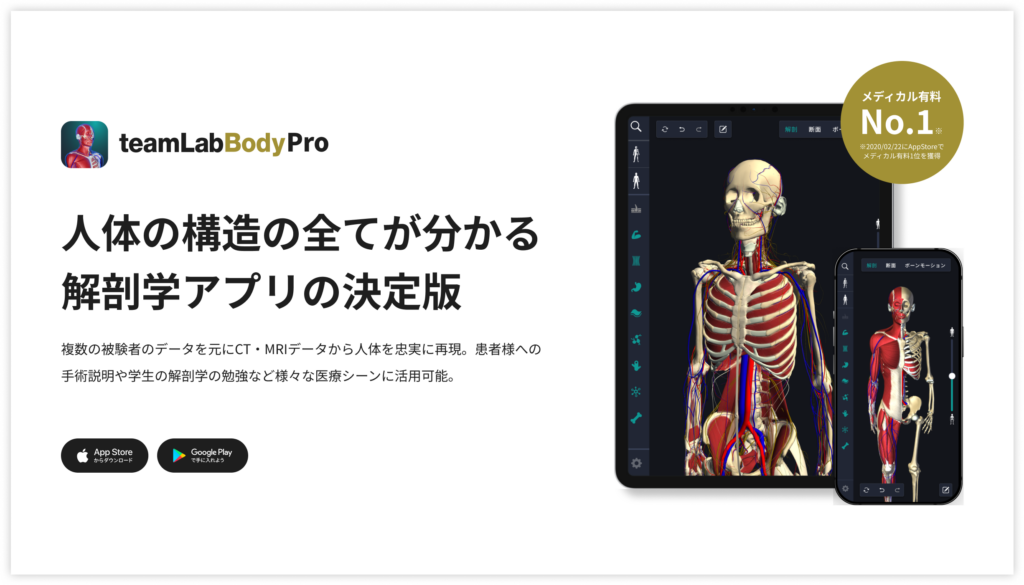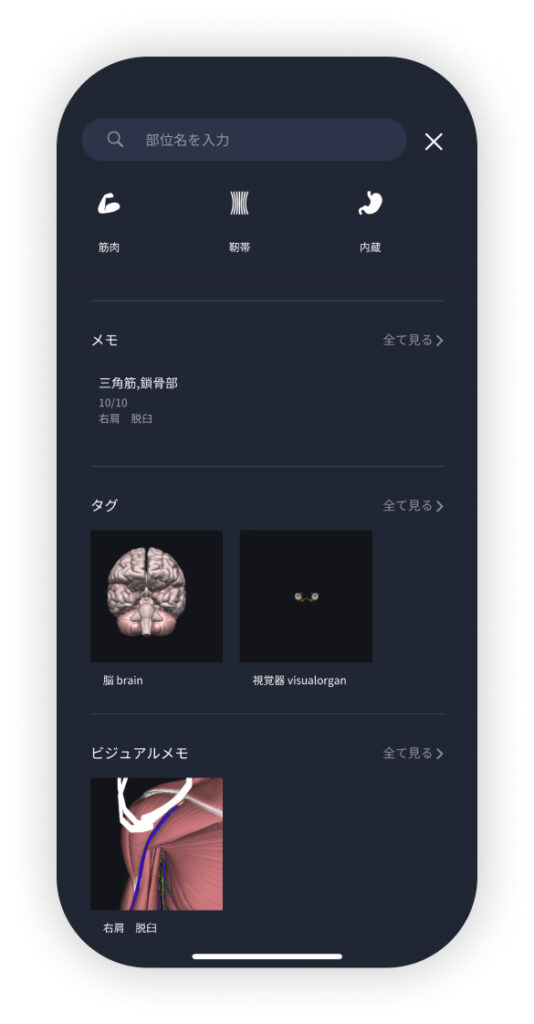beginning
In this article, I will explain effective study methods, starting with knowledge of specialized parts in human anatomy.
In human anatomy, it is necessary not only to memorize the names of various organs, muscles, and bones, but also to remember where they are located in the body. Therefore, it is necessary to learn as efficiently as possible.
I hope you will deepen your understanding even a little by reading this article and using the app.
Now, I will explain the contents of the “hyogyo-epiglottic ligament” and how to study human anatomy.
teamLab Body Pro Free Download
A 3D anatomy app that shows all the structures of the human body
Download teamLab Body Pro here!

What is hyogyopharyngeal ligament?
The anatomy application allows you to view a selection of anatomy 3D models. In this model, there are various observation methods such as surfaces, cross-sections, and nervous systems. This time, I'll explain using an anatomy application.
About hyogyopharyngeal ligament

hyogyopharyngeal ligament(hyoepiglottic ligament) is an important anatomical structure connecting the hyoid bone to the epiglottis, and plays an important role in swallowing and breathing. This ligament connects the upper part of the hyoid bone to the lower end of the epiglottis and supports the proper position of the epiglottis.
The hyoid bone is located below the jaw, and the epiglottis plays a role in protecting the vocal cords. When swallowing, the epiglottis closes to protect the airways and prevents food from entering the trachea. The hyogopharyngeal ligament affects this movement of the epiglottis, increases swallowing efficiency, and at the same time functions so that the epiglottis keeps the airway open during breathing.
The hyoid epiglottis ligament also contributes to the anatomical stability of the larynx and controls the extent to which the epiglottis moves in cooperation with the hyoid bone. In particular, during swallowing or breathing, the movement of the epiglottis to reflexively close so that food or liquid does not accidentally enter the trachea is supported by this ligament.
Study points
Anatomical understanding: location and role of hyaco-epiglottid ligament
The hyoid epiglottis ligament connects the hyoid bone to the epiglottis and is an important structure involved in swallowing and breathing. For learning, it is effective to use detailed anatomical diagrams of the larynx and 3D apps. In order to understand how this ligament connects the hyoid bone to the epiglottis and how it contributes to swallowing and breathing movements, it is important to visually grasp the anatomical structure. Also, if you are aware of the positional relationship with other structures around the larynx (vocal cords, laryngeal cartilage, pharynx, etc.), you can understand the function of ligaments more deeply.
Functional understanding: mechanisms of swallowing and breathing
In order to understand the role of the hyoepiglottis ligament, it is effective to actually experience swallowing and breathing movements. By feeling how the epiglottis closes and protects the airways when swallowing food, you can understand how ligaments work. Also, if you are aware of how the epiglottis opens the airways during breathing and how epiglottis movement contributes to breathing efficiency, your functional understanding will deepen.
Practical application: clinical importance
The hyogopharyngeal ligament plays an important role in treating dysphagia and airway abnormalities. For instance,dysphagia(dysphagia) andlaryngeal abnormalitiesGyroepiglottis ligament dysfunction is a problem in related diseases. Clinically, in order to evaluate the closing function of the epiglottis during swallowing, the condition of this ligament is examined using laryngoscopy or swallowgraphy. Also, in rehabilitation, exercises to improve swallowing and treatment to restore mobility of the hyogyo-epiglottic ligament may be performed.
How to study human anatomy
I will explain specific study methods using human anatomy applications.
Check your past learning history and practice repeatedly
Here are the steps to check your anatomy learning history and practice iteratively effectively.
1. Check your learning history in the app
Reviewing your learning history with the application is an important step in effectively advancing anatomy learning. First, launch the app and go to the learning history section from the main menu. Many anatomy apps are designed to show your progress in the form of graphs and lists, so you can visually check which parts you've learned about and how much time you've spent.
By using this data, you can understand which areas you have strengths in and where you need to spend more time and effort. We also recommend using a dedicated tag or notebook function to mark areas you are particularly weak at or where you need to relearn. Regularly checking your learning history and looking back on past learning content will lead to efficient review and deepening understanding.
2.Make a plan for iterative learning
Making an efficient repetitive learning plan based on learning history is extremely effective in promoting knowledge retention. First, identify weak points and areas where you need to relearn. Next, arrange these study items into a weekly or monthly calendar and create a specific study schedule. By proceeding in a planned manner, you can learn each part evenly and avoid packing in a large amount of information at once.
Using a task management app or digital calendar to set study reminders is effective. Also, it's important to have the flexibility to regularly review progress and revise plans as needed. By having goals and proceeding with your studies in a planned manner, you can efficiently acquire anatomical knowledge.
3.Use 3D features to learn visually
By utilizing the 3D function, learning anatomy is easier to understand visually. The 3D model shows the structure of the human body three-dimensionally, and each part can be observed in detail. This makes it possible to intuitively grasp positional relationships between deep muscles and organs that are difficult to capture in a planar view. For example, you can learn even the smallest details by rotating specific muscles and bones and zooming in and out.
Also, there are many apps that have the function of displaying cross-sectional views of each part using a 3D model, which is useful for deepening understanding of internal structures. This diversity of visual information helps with memory retention and improves immediate responsiveness in tests and practice situations. By utilizing the 3D function and learning visually, you can learn anatomy knowledge more deeply and efficiently.
Use the memo function concretely

Make notes so you don't forget the things and points you've noticed while studying. The memo function can be used for different purposes, such as inputting text, saving images, and writing memos. Tag your notes to make them easier to review later.
Test your learning regularly in the form of quizzes
Regularly testing what you've learned in a quiz format is a very effective way to anchor your anatomy knowledge. Quiz-style tests help you objectively grasp your level of understanding and areas you lack while repeating knowledge.
For example, by using a learning app to conduct quizzes every specific period, you can reconfirm what you've learned and strengthen your memory. There are a wide range of quiz formats, such as multiple choice questions, fill-in-the-blank questions, and short answer questions, and each helps understanding from a different angle and develops the ability to utilize various types of knowledge.
Get feedback
If possible, get feedback from other learners and experts. It helps you find your own gaps in understanding and areas for improvement. You can also keep yourself motivated to learn by regularly testing yourself. Feeling a sense of accomplishment and progress increases motivation for continuous learning.
summary
This time, I explained how to study about the “hyogyo-epiglottic ligament” using an application!
Thank you for reading this far.
I would be happy if reading this article helped you learn about anatomy.
Learning is a long, never-ending journey, but I sincerely wish you all the best. Let's continue to study together and work hard for the national exam!
Please look forward to the next blog.
teamLab Body Pro Free Download
A 3D anatomy app that shows all the structures of the human body
Download teamLab Body Pro here!





